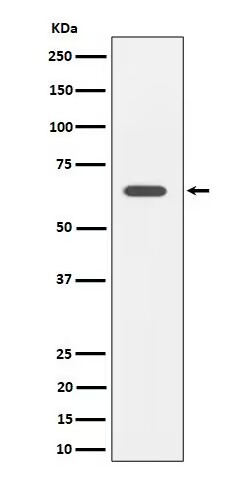SOCS7 Antibody
Rabbit mAb
- SPECIFICATION
- CITATIONS
- PROTOCOLS
- BACKGROUND

Application
| WB, IHC |
|---|---|
| Primary Accession | O14512 |
| Clonality | Monoclonal |
| Other Names | Ash and phospholipase C gamma-binding protein; NAP4; Nck; Nck Ash and phospholipase C binding protein; Nck associated protein 4; NCKAP4; SH2 domain containing SOCS box protein; SOCS4; SOCS6; Socs7; Suppressor of cytokine signaling 7; |
| Isotype | Rabbit IgG |
| Host | Rabbit |
| Calculated MW | 62969 Da |
| Dilution | WB 1:500~1:2000 IHC 1:50~1:200 |
|---|---|
| Purification | Affinity-chromatography |
| Immunogen | A synthesized peptide derived from human SOCS7 |
| Description | Regulates signaling cascades probably through protein ubiquitination and/or sequestration. Functions in insulin signaling and glucose homeostasis through IRS1 ubiquitination and subsequent proteasomal degradation. Inhibits also prolactin, growth hormone and leptin signaling by preventing STAT3 and STAT5 activation, sequestering them in the cytoplasm and reducing their binding to DNA. |
| Storage Condition and Buffer | Rabbit IgG in phosphate buffered saline , pH 7.4, 150mM NaCl, 0.02% sodium azide and 50% glycerol. Store at +4°C short term. Store at -20°C long term. Avoid freeze / thaw cycle. |
| Name | SOCS7 {ECO:0000303|PubMed:16127460, ECO:0000312|HGNC:HGNC:29846} |
|---|---|
| Function | Substrate-recognition component of a cullin-5-RING E3 ubiquitin-protein ligase complex (ECS complex, also named CRL5 complex), which mediates the ubiquitination and subsequent proteasomal degradation of target proteins, such as DAB1 and IRS1 (PubMed:16127460). Specifically recognizes and binds phosphorylated proteins via its SH2 domain, promoting their ubiquitination (By similarity). The ECS(SOCS7) complex acts as a key regulator of reelin signaling by mediating ubiquitination and degradation of phosphorylated DAB1 in the cortical plate of the developing cerebral cortex, thereby regulating neuron positioning during cortex development (By similarity). Functions in insulin signaling and glucose homeostasis through IRS1 ubiquitination and subsequent proteasomal degradation (PubMed:16127460). Also inhibits prolactin, growth hormone and leptin signaling by preventing STAT3 and STAT5 activation, sequestering them in the cytoplasm and reducing their binding to DNA (PubMed:15677474). |
| Cellular Location | Cytoplasm. Nucleus Cell membrane; Peripheral membrane protein; Cytoplasmic side. Note=Mostly cytoplasmic, but shuttles between the cytoplasm and the nucleus (PubMed:17803907). Rapidly relocalizes to the nucleus after UV irradiation (PubMed:17803907) Cytoplasmic location depends upon SEPT7 presence (PubMed:17803907) |
| Tissue Location | Expressed in brain and leukocytes (PubMed:9344857). Also in fetal lung fibroblasts and fetal brain (PubMed:9344857) |

Thousands of laboratories across the world have published research that depended on the performance of antibodies from Abcepta to advance their research. Check out links to articles that cite our products in major peer-reviewed journals, organized by research category.
info@abcepta.com, and receive a free "I Love Antibodies" mug.
Provided below are standard protocols that you may find useful for product applications.
If you have used an Abcepta product and would like to share how it has performed, please click on the "Submit Review" button and provide the requested information. Our staff will examine and post your review and contact you if needed.
If you have any additional inquiries please email technical services at tech@abcepta.com.













 Foundational characteristics of cancer include proliferation, angiogenesis, migration, evasion of apoptosis, and cellular immortality. Find key markers for these cellular processes and antibodies to detect them.
Foundational characteristics of cancer include proliferation, angiogenesis, migration, evasion of apoptosis, and cellular immortality. Find key markers for these cellular processes and antibodies to detect them. The SUMOplot™ Analysis Program predicts and scores sumoylation sites in your protein. SUMOylation is a post-translational modification involved in various cellular processes, such as nuclear-cytosolic transport, transcriptional regulation, apoptosis, protein stability, response to stress, and progression through the cell cycle.
The SUMOplot™ Analysis Program predicts and scores sumoylation sites in your protein. SUMOylation is a post-translational modification involved in various cellular processes, such as nuclear-cytosolic transport, transcriptional regulation, apoptosis, protein stability, response to stress, and progression through the cell cycle. The Autophagy Receptor Motif Plotter predicts and scores autophagy receptor binding sites in your protein. Identifying proteins connected to this pathway is critical to understanding the role of autophagy in physiological as well as pathological processes such as development, differentiation, neurodegenerative diseases, stress, infection, and cancer.
The Autophagy Receptor Motif Plotter predicts and scores autophagy receptor binding sites in your protein. Identifying proteins connected to this pathway is critical to understanding the role of autophagy in physiological as well as pathological processes such as development, differentiation, neurodegenerative diseases, stress, infection, and cancer.


